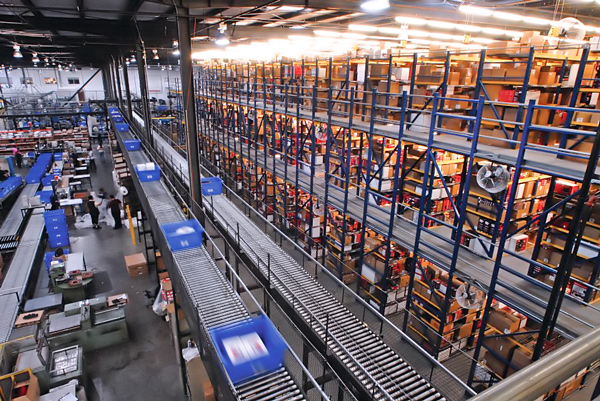2025 Industrial Trends: What to Expect
February 2025 Insights

As we mentioned last month, you can expect increases in 2025 shipping costs and fees, particularly in the heavy package sector. What else can you expect in 2025 in the manufacturing, warehousing and distribution spaces?
Modern Materials Handling: What automation trends should you watch this year?

Modern Materials Handling annually surveys its readers on key trends. Its 2025 Automation Survey examines the increasing integration of technology and automation in warehouse and distribution center operations. For 2025, warehouses and DCs are already focused on capacity utilization, with 67% of respondents reporting their need to improve this critical area. Accuracy is another priority, with 58% of respondents reporting a need to improve. Almost half of all warehouses are looking at ways to optimize their packaging functions.
Investment drivers
- Order Fulfillment Efficiency: Companies are investing in automation to expedite order processing and meet customer expectations.
- E-commerce Growth: The rise in e-commerce has led to increased piece picking and packing, prompting the adoption of automated solutions.
- Labor Challenges: Persistent labor shortages are encouraging firms to explore automated alternatives to traditional manual processes.
See more: Warehouse Automation: The Cost of Doing Nothing for a deep analysis if warehouse labor and cost trends. This is a matter of opportunity cost for the sector.
Automation adoption
Functions like reporting (15%), labeling (10%), and conveyance (9%) have been fully automated in some operations, while others lag behind. Obviously with these percentages, these are fertile areas for adoption for many companies. Many companies continue to rely on manual methods for storage (39%), replenishment, and retrieval, though there is interest in future automation.
Spending patterns: where the money is going
- Budget Allocation: In 2025, 36% of companies plan to increase spending on materials handling equipment and solutions, with an average projected expenditure of $1.5 million.
- Investment Focus: Planned investments include hoists, cranes, monorails (42%), palletizers, pallets, totes, bins, containers (31%), and dock equipment (26%).
Technology utilization: what’s in place
77% of companies use mobile and wireless technologies for data collection, while 76% employ barcode scanners. Warehouse management systems are utilized by 63% of respondents, with other software solutions like transportation management systems (62%) and warehouse control systems (50%) also in use.
The survey indicates a clear trend toward increased automation in warehouse and DC operations, driven by the need for greater efficiency, accuracy, and adaptability in a rapidly evolving labor market.
How will AI affect manufacturing in 2025?

AI isn’t just the next buzzword, it’s quickly becoming the secret weapon in manufacturing’s evolution. In 2025, it’s not about if AI will change the game but how fast companies can keep up. From smarter machines to predictive maintenance, AI is paving the way for leaner, more agile production. Here’s a look at three major ways it’s making waves this year:
- Enhanced Efficiency and Productivity: AI-powered machines optimize production processes, reducing waste and improving efficiency.
- Advanced Robotics and Automation: AI is at the heart of advancements in manufacturing, driving real-time decision-making, near-autonomous systems, and seamless human-machine collaboration.
- Predictive Maintenance and Quality Control: AI enables predictive maintenance by analyzing data to foresee equipment failures, reducing downtime and maintenance costs. Additionally, AI-powered computer vision systems enhance quality control by detecting defects with greater precision.
Is the industrial real estate market ready to peak in 2025?

The latest Cushman & Wakefield industrial report is out, and the sector is still flexing its muscles despite a few bumps in the road. Here’s what’s making waves as we gear up for 2025:
- Absorption Holds Strong: Net absorption hit 36.8 million square feet in Q4 2024, capping the year at 135 million square feet. While most markets saw gains, a few (looking at you, Los Angeles and Central Valley) took a hit as companies tightened their belts.
- Construction Takes a Breather: New supply dropped to 85.3 million square feet in Q4, the lowest level since mid-2021. With 78% of the new builds being speculative, it’s no surprise vacancy rates nudged up in some markets.
- Vacancy: A Turning Point? The vacancy rate ticked up to 6.7% in 2024, but here’s the twist…Q4 saw the slowest rise since 2022, hinting that we might hit peak vacancy early this year before things settle down.
- Smaller Spaces, Bigger Demand: The construction pipeline is pivoting to meet demand for mid-sized facilities (100,000–500,000 sq. ft.). Meanwhile, those massive million-square-foot warehouses? They’re becoming a rarity, making up just 7% of new developments.
With the pipeline shrinking and speculative builds slowing, 2025 could be a year of supply constraints. But let’s not forget: e-commerce growth and nearshoring are ready to turbocharge demand and keep the market humming.
We’re investing less in China than ever in 2025 – and the trend is accelerating
Foreign investment in China is constricting, and the trend is sharp, according to this infographic from Visual Capitalist. In 2011, foreign direct investment into China was $298 billion. It peaked at $344 billion as recently as 2022 and dropped to just $15 billion in 2023. While the Chinese government directly invests in its own manufacturing base and infrastructure, the reduction in foreign investment is a red flag for the future of China’s manufacturing sector.
Not only is new investment lagging, foreign investors are fleeing. Foreign firms are selling off their Chinese investments rather than making new ones.
Quick hits
- The Federal Reserve Bank of St. Louis forecasts relatively slowing economic activity with real GDP growth of 2.1% year-over-year. Unemployment rates continue to be low (forecast of 4.3%), accompanied by expected inflation of 2.4%. This is an analysis of the bank’s blue chip economic forecasters.
- The United States and China consume nearly 50% of all fossil fuels globally according to Visual Capitalist. India is third with only a third of American consumption. These countries are also the major manufacturing powers and automation implementation, driving this dynamic. China boasts a robotics usage rate of 322 robots per 10,000 workers. America’s rate of automation lags China at 274 robots per 10,000 workers. The global average is 141 per 10,000, according automation expert Chad Stroud. These factors illustrate the current and future direction of global manufacturing.
- The U.S. Bureau of Economic Analysis reports that America’s monthly international trade deficit increased in 2024. Where will 2025 take us? We know that exports of industrial inputs exceeded those of capital goods. These exports include industrial supplies and energy exports. Collectively, those goods exceeded capital goods exports in 2024, for the first time in many years.
Scott Stone is Cisco-Eagle's Vice President of Marketing with 35 years of experience in material handling, warehousing and industrial operations. His work is published in multiple industry journals an websites on a variety of warehousing topics. He writes about automation, warehousing, safety, manufacturing and other areas of concern for industrial operations and those who operate them.



